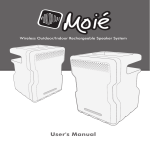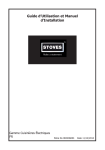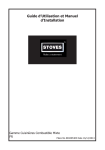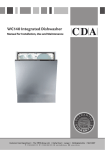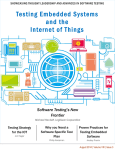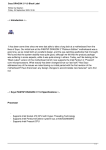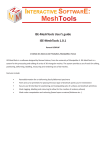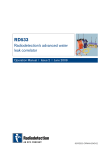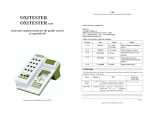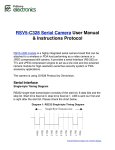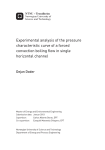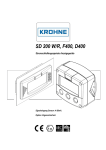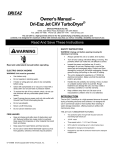Download User Manual
Transcript
Users Guide & Installation Handbook Belling FSI60MFT AU Part No 083486700 Date 06/05/2015 CONTENTS & OUR WARRANTY CONTENTS Important Notice • SAFETY • USING THE PRODUCT • CLEANING • INSTALLATION INSTRUCTIONS • TECHNICAL DATA • WIRING DIAGRAMS • CUSTOMER CARE Please note there may be a cooling fan fitted to this appliance. It is an integral part of its safety and functionality. When the appliance is installed care must be taken that the cooling fans performance is not impeded by any objects coming into contact with it. (Installation pipes, leads etc) Care must also be taken that there is sufficient air flow at the rear of the appliance for the cooling fan to run at its optimum efficiency, (particularly built in appliances) see clearance dimensions in the installation section of the booklet. During use the appliance must never be disconnected from the mains supply as this will seriously affect the safety and performance of the appliance, particularly in relation to surface temperatures becoming hot and gas operated parts not working efficiently. The cooling fan is designed to run on after the control knob has been switched off to keep the front of the appliance and the controls cool until the appliance has naturally cooled itself. INTRODUCTION Should you need it . . . . Inside the paperwork which has come with this appliance, there is a leaflet and card explaining the terms of our warranty and guarantee. Simply fill in the details on the card and post it off, this will register your appliance. Glen Dimplex Australia PTY LTD 1/21 Lionel Road Mount Waverley Victoria 3149 Australia Ph: 1300 556 816 Fx: 1800 058 900 Glen Dimplex New Zealand Pty 38 Harris Road, East Tamaki Auckland New Zealand Ph: 09 274 8265 Fx: 09 274 8472 If your appliance is covered by the warranty and guarantee, you will not be billed for work undertaken should your appliance be faulty, terms and conditions do apply, so please read through the literature carefully. Please ensure that you have available your appliances model number and serial number, there is a space at the back of this book for recording that information. SAFETY BEFORE USING THE PRODUCT Make sure that you have removed all packaging and wrapping. Some of the items inside this appliance may have additional wrapping. It is advised that you turn the ovens and/ or grill on for a short while. This will burn off any residues left from manufacturing. There may be a smell which accompanies this process - but this is nothing to worry about and is harmless. It is recommended that you wash the oven shelves, baking tray, grill pan and grill pan trivet before their first use in hot soapy water. This will remove the protective oil coating. WARNING! - The appliance and its accessible parts become hot during use. Care should be taken to avoid touching heating elements. Children less than 8 years of age shall be kept away unless continously supervised.This appliance can be used by children aged from 8 years and above and persons with reduced physical sensory or mental capabilities or lack of experience and knowledge if they have been given supervision or instruction concerning the use of the appliance in a safe way and understand the hazards involved. Children shall not play with the appliance. Cleaning and user maintenance shall not be made by children without supervision. WARNING! - Unattended cooking on a hob with fat or oil can be dangerous and may result in fire. NEVER try to extinguish a fire with water, but switch off the appliance and then cover the flame with a lid or damp cloth. WARNING! - Danger of fire: Do not store items on the cooking surfaces. WARNING! - Servicing should be carried out only by authorised personnel. WARNING! - The appliance must never be disconnected from the mains supply during use, as this will seriously affect the safety and performance, particularly in relation to surface 5.130 SAFETY temperatures becoming hot and gas operated parts not working efficiently. The cooling fan (if fitted) is designed to run on after the control knob has been switched off. WARNING! - Do not spray aerosols in the vicinity of this appliance while it is in operation. WARNING! - Do not store or use flammable liquids or items in the vicinity of this appliance. WARNING! - Do not modify this appliance. WARNING! - Do not use harsh abrasive cleaners or sharp metal scrapers to clean the oven door glass since they can scratch the surface, which may result in shattering of the glass. WARNING! - Do not operate the appliance without the glass panel correctly fitted. WARNING! - There is a risk of electric shock, so always make sure you have turned off and unplugged your appliance before starting. Always allow the product to cool down before you change a bulb. WARNING! - Accessible parts may become hot when the grill is in use. children should be kept away. WARNING! - Never place food, or dishes on the base of the main oven, the element is here and it will cause over heating. WARNING! - Do not modify the outer panels of this appliance in any way. WARNING! - This appliance must be earthed. WARNING! - The top element gets extremely hot when in use, so take care to avoid touching it. 5.130 SAFETY ELECTRIC INDUCTION HOB WARNING:- Unattended cooking on a hob can be dangerous and may result in fire. NEVER try to extinguish a fire with water, but switch off the appliance and then cover flame e.g. with a lid or a damp cloth. Danger of fire: do not store items on the cooking surface. If the surface is cracked, broken or shattered, switch off the appliance to avoid the possibility of electric shock and call for a service engineer’s visit. Metallic objects such as knives, forks, spoons and lids should not be placed on the hob surface since they can get hot. Ensure you switch off the appropriate cook zone individually or (by the central on/off key if touch control) when you have finished cooking, do not rely upon the automatic pan detection system as your means of switching “off” the appliance. This induction hob complies with the applicable EMC and EMF standards. Therefore it should not interfere with other electronic units. Persons fitted with a pacemaker or any other electrical implant should clarify with their doctor or the producer of the implant, whether there implant is adequate and fail-safe, the pacemaker must be designed in compliance with the appropriate regulations. Caution: This appliance is for cooking purposes only. It must not be used for other purposes, for example room heating. OVEN/GRILL Do • Always take care when removing food from the oven as the area around the 5.130 SAFETY cavity may be hot. • Always use oven gloves when handling any utensils that have been in the oven as they will be hot. • Always make sure that the oven shelves are resting in the correct position between two runners. Do not place the oven shelves on top of the highest runner, as this is not stable and can lead to spillage or injury. Always use the Minute Minder (if fitted) if you are leaving the oven unattended this reduces the risk of food burning. hob. • Always position pans over the centre of the heat zone, and turn the handles to a safe position so they cannot be knocked or grabbed. Always use pans which are no smaller than 100mm (4”), or no larger than 250mm (10”). • Always match the size of pan to the size heat zone – do not use large pans on small zones or vice versa. • Always lift pans onto and off the hob, rather than sliding them across the surface, to avoid marks and scratches. Do Not • Never place items on the door while it is open. • Never wrap foil around the oven shelves or allow foil to block the flue. • Never drape tea towels near the oven while it is on; this will cause a fire hazard. • Never pull heavy items, such as turkeys or large joints of meat, out from the oven on the shelf, as they may overbalance and fall. • Never use this appliance to heat anything other than food items and do not use it for heating the room. • Do not spray aerosols in the vicinity of this appliance while it is in operation. • • Do not store or use flammable liquids or items in the vicinity of this appliance. Do Not • If the appliance has a glass hobtop, never drag pans across the ceramic surface as this will lead to scratches and damage. • Never use double pans, rim-based pans, old or misshapen pans, or any pan that is not stable on a flat surface. • Never leave cooking fat, or oil, unattended. • Never use commercial simmering aids, or heat diffusers, as they create excessive heat and can damage the surface of the hob. • Never use the hob for any other purpose than cooking food. • Never leave plastic cooking utensils close or on top of the hob as these can melt due to the warm hob. • Never leave any cook zone on without a pan covering it. This causes a fire hazard. • Never leave pans overhanging the edge of the hob. The surface of the hob is smooth. If pans are knocked they may move on the hob top. • Never leave pans on the hob when Do not modify this appliance. GENERAL Do • Always ensure that pan bases are dry and flat before using them on the 5.130 SAFETY you’re not around - take them off the cook zone or use a dry powder or carbon dioxide extinguisher • FIRE SAFETY ADVICE Remember: never use water on an electrical or cooking oil fire. Most kitchen fires occur when people are distracted or leave things unattended, so remember: If you’re called away from the cooker - by the phone or someone at the door, either take pans off the heat, or switch off your hob. Don’t let yourself be distracted while cooking. If you do have a fire in the kitchen, don’t take any risks - get everyone out of your home and call the Fire Brigade. If a pan catches fire: • Do not move it - it is likely to be extremely hot. • Turn off the heat if it’s safe to do so - but never lean over a pan to reach the controls. • If you have a fire blanket, put it over the pan. • If you have put the fire out, leave the pan to cool completely. Deep-fat frying presents more dangers in your kitchen. • Never fill a chip pan (or other deepfat fryer) more than one-third full of oil • Do not use a fire extinguisher on a pan of oil - the force of the extinguisher can spread the fire and create a fireball. If you have an electrical fire in the kitchen: • Pull the plug out, or switch off the power at the fuse box - this may be enough to stop the fire immediately • Smother the fire with a fire blanket, 5.130 USING THE HOB - INDUCTION Before using your hob It is recommended that you clean and wash the hob surface before using for the first time. Apply a thin coat of ceramic hob cleaner to the hob to maintain and protect it. See the customer care section for details of how to obtain all the available cleaning products. Basic Control Functions 6 2 1 1 TOUCH CONTROLS The touch controls for your induction hob have been designed to provide you with finger tip control of your hob, providing accurate and repeatable power settings for cooking and an easy clean surface that can be easily wiped over. When a cook zone is activated the power setting is displayed for each zone individually. 3 4 5 2 2 Note; Generic illustration shown above your appliance may visually differ. 1 COOK ZONE KEYS 2 INDIVIDUAL COOK ZONE DISPLAYS 3 POWER DOWN KEY (-) Using the Touch Controls. 4 POWER UP KEY (+) Use the flat of your finger, not the tip, the controls respond to touch, so you don’t need to apply any pressure. 5 ON/OFF KEY 6 TIMER DISPLAYS Always ensure the control area is clean, dry and free from of any objects (e.g. utensils, tea towels and cloths), spillages and water may make the controls difficult to operate. A warning will be activated and will beep to attract your attention. ER03 will be displayed and the control will switch off after 10 seconds. Please remove any objects and clean the control area as appropriate. Child Lock “L” This feature is to help prevent accidental switching on of the hob, especially by young children. To Activate: 1) Select the On/Off Key. 2) Simultaneously touch the right hand front (RHF) cook zone and the down [-] key, the hob should beep. 3) Remove fingers and touch the RHF cook zone again. (L should appear in all the cook zone displays). 4) Switch off the hob. When you now switch on the hob “L” will appear in all the cook zone displays. The child lock feature will be permanently activated, to de-activate follow the procedure below. USING THE HOB To de-activate the child lock: normal brightness. 1) Select the On/Off Key. (L will be displayed on all Cook Zones). 2) Select the required power setting using the up +/down – keys. 2) Simultaneously touch the RHF cook zone and the down [-] key, the hob should beep. Switching off an individual hob cook zone 3) Remove fingers and touch the down [-] key again. (The hob should switch off). 4) When you now switch on the hob “0” will be displayed in all cook zone displays, the hob can now be used normally. Central On/Off switch The central on/off switch enables all of the cooking zones to be switched off simultaneously at a touch of a key. To switch on the hob The hob is switched On by touching the“ON/OFF” key for 1 sec. A beep sounds and all the heater displays show a full stop in the cook zone display. If a heater is not selected in 10 seconds, the hob will turn off automatically. The hob is switched off by touching the“ON/OFF” key for 1 second. A beep sounds and all the heaters are switched off. Switching on an individual hob cook zone To switch on a cook zone it is necessary to actuate every cooking zone by means of two operations: Once the cook zone is selected, it can be switched off by touching the down [-] key until the corresponding display shows “0”. Power Boost Temporarily boost the power to a cook zone by approximately 30%. All cook zones can be boosted for a period of up to 5 minutes. After 5 minutes a beep sounds and the heater will return to level “9”. Quick Operation With the cook zone at power level 0, touch the down [-] key the power level will raise straight to 9. With the cook zone at power level 9, touch the up [+] key the power level will raise to the Power Boost level and a beep sounds and the heater display shows “P”. MINUTE MINDER The minute minder uses the displays for the two rear cook zones, either side of the clock symbol. The minute minder beeps when the set time has expired – it does not switch off any zone. To operate 1) Turn on the hob, using the on/off key. 1) Touch the required cook zone key for approximately 1 second a beep sounds and the heater display shows the power level with normal brightness. 2) Ensure that no cooking zones have been selected. Select the minute minder by pressing the up [+] and down [-] keys simultaneously – the display will show 00. The cook zones that are not selected are dimmed. When the cook zone selection is finished after 10 seconds, a beep sounds and all the heater displays that were dimmed show the power levels with 3) Set the minute minder by pressing the USING THE HOB up [+] and down [-] keys. Pressing down [-] first sets the timer to 30 minutes. This can then be adjusted using the up [+] and down [-] keys. 4) The maximum time that can be set is 99 minutes. 5)The minute minder is now set and begins counting down. To operate 1) Select the cook zone to be timed, ensuring power level is already set before selecting timer. 2) Select the timer by pressing the up [+] and down [-] keys simultaneously – the timer display will show 00 6) You can now use the hob as normal. 7) If the hob is turned off then minute minder operation is shown by flashing dots on the display. When the time is up 1) The minute minder will beep and the timer display flashes. 2) Touch any key to stop. Additional minute minder information To modify or cancel the minute minder:- 3) Set the timer by pressing the up [+] and down [-] keys. Pressing down [-] first sets the timer to 30 minutes. This can then be adjusted using the up [+] and down [-] keys. 4) The timer indicator in the display stops flashing and is not displayed. Operation of a timer is shown by a stationary dot in the cook zone display for the timed cook zone. When the time is up 1) Follow steps 1 to 5 above if the hob is turned off. 1) The timer display will flash, the timer will beep and the cook zone will automatically turn off. 2) Follow steps 2 to 5 above if the hob is turned on. 2) The timed cook zone display will show a flashing dot. 3) Setting back to zero will cancel the minute minder. TIMER AUTO SWITCH OFF The timer uses the displays for the rear cook zones, either side of the clock symbol. The timer can be set to automatically turn off a cooking zone. All four cook zones can be simultaneously timed to turn off automatically. Cook zones can be set for a maximum time of 99 minutes. Warning: Never leave the hob unattended when in use, even when you have set the timer to turn off the cook zone. 3) Touch any key to stop the beeping. Additional timer information To modify or cancel a timer follow steps 1 to 4 above in “To operate”. Setting back to zero will cancel the timer. To set the timer for additional zones follow steps 1 to 4 above in “To operate”. To check the timer setting for a cook zone select a timed cook zone and then press the up [+] and down [-] keys simultaneously to show the time remaining. If multiple timers have been set then the timers can be checked as follows:1) Ensure that a cooking zone has not USING THE HOB been selected. disconnected from the mains supply during use as this will seriously affect the safety and performance, particularly in relation to surface temperatures becoming hot and component parts not working efficiently. The cooling fan (if fitted) is designed to run on after the cook zones have been switched off. 2) Select the timer by pressing the up [+] and down [-] keys simultaneously. 3) Press the up [+] and down [-] keys as many times as necessary to display the timer for the required cook zone (the active cook zone times are cycled clockwise). The stationary dot in the cook zone display will flash when the timer is displayed for that zone. • 4) If the minute minder has also been set it will be displayed first. In this case other timed cooking zones are shown by a stationary dot in the cook zone display. Pan Detection As soon as you lift the pan off the zone the power is automatically reduced, helping to save energy. • This induction hob complies with the applicable EMC and EMF standards. Therefore it should not interfere with other electronic units. Persons fitted with a pacemaker or any other electrical implant should clarify with their doctor or the producer of the implant, whether there implant is adequate and fail-safe, The pacemaker must be designed in compliance with the appropriate regulations. The above “U” symbol appears when a zone has been activated but no pan has been placed on the cook zone, PANS AND COOKWARE FOR INDUCTION HOBS If the “U” symbol does not disappear when a pan is placed on the zone it indicates that the pan is not suitable for induction cooking. Pans and Cookware for induction cooking zones must be made of ferrous material such as cast iron and have magnetic properties. The base must also be of the correct diameter. Note This means the hob only uses power when a suitable pan is placed on the zone, this reduces the energy used during the cooking process, i.e. when you take your pan off the zone the hob automatically reduces the power, and only switches back on when you replace the pan. • • WARNING:- Ensure you switch off the appropriate cook zone individually or by the central on/off key when you have finished cooking, do not rely upon the automatic pan detection system as your means of switching “off” the appliance. The appliance must never be It’s important that good quality flat bottomed pans are used. If a pan creates a large air gap over the middle of the cooking zone, the accuracy of the temperature sensing can be affected. Always ensure that pan bases are dry before using them on the hob. Get a magnet, if a magnet doesn’t stick to your pan, it is not suitable for use on the induction hob. Beware:- Not all induction pans are of the same quality due to their construction. Pans that use enamelled/laminated/ encapsulated bases can be difficult to USING THE HOB detect, especially small pans (e.g. milk pans). We recommend that you buy pans that are marked/advertised as being suitable for induction. This problem is not with induction hob but with the pan type, they can have bases which are magnetic but are not thick enough! If you experience problems with small pans we recommend that you try a larger pan or a pan of a different construction. Solid cast iron pans give the best performance. Approximate Glass Temperature oC Hob Action 255 Cooking zone switches off with the error message “E2” 265 All cooking zones are switched off with the errors message “E2” Note: Induction Cook Zone Smallest Recommended Diameter (mm) LHF 130 The safety temperature control of the pans is only possible with quality flat bottomed pans suitable for induction cooking; Poor quality pans can create air gaps between the glass and the pan, which affects the accuracy of the temperature control. LHR 130 Residual Heat Indicators RHR 130 RHF 130 If glass surface is above 65oC when the cook zone is switched off an “H “will be displayed in the cook zone display until the glass surface drops below approximately 63oC. Cookware made of enamelled steel or with aluminium or copper bottoms can leave discolorations on the ceramic glass surface which are difficult or impossible to remove. Pans unsuitable for Induction: Pans made of copper, stainless steel, aluminium, oven proof glass, wood, ceramic and terra-cotta. Overheat Pan Protection The hob is equipped with additional safety systems that help to prevent cookware from overheating, providing an additional level of safety not available on conventional hobs such as gas and ceramic hobs. Helps reduce the risk of fire through misuse use of hob. If there is an overheat situation the hob will display the appropriate code detailed in the “hob status codes table”. This feature not only warns you against hot surfaces but also indicates that there is residual heat which can be used as temporary warm zone. Note: The cook zone itself does not heat up, but the ceramic glass does get hot because of the hot pan conducting heat back onto the hob glass. Auto Stand by The Hob will automatically switch off if left (with pan) on for an extended period of time, see maximum running times below. USING THE HOB Power Level Maximum Operation Time hours 1 8 2 6 3 5 4 5 5 4 6 1.5 7 1.5 8 1.5 9 1.5 P (Power Boost) Max 5mins Pans make a noise during cooking This is caused by vibration due to the passage of energy from the hob to the pan. On a high setting this is quite normal for certain types of saucepan. It will not damage the hob. The hob makes a slight clicking sound This is caused by the distribution of power between two heating zones on the same side of the hob. The hob won’t work. The indicators don’t come on The electricity supply is not reaching the appliance (faulty supply or connection); Energy Saving Tips Check the fuses and the cut-out switch. Always place cookware on the cooking zone before it is switched on. When ever possible place lids on pans. Refer to Troubleshooting chart and if problems persist call, the customer service hot line for further assistance. TROUBLESHOOTING The fan keeps working for a few minutes after the hob has been turned off The hob produces a smell the first few times it is used Heat a pan full of water on each zone for half an hour. There are cooling fans fitted to this appliance which will operate when the appliance is on and until the appliance is sufficiently cooled. Appliance Errors Fault Description Action ER03 and permanent tone Continuous button actuation; control switches off after 10 s Clean the user interface. E2 Over temperature Allow system to cool E3 1. Pot/pan not suitable, example Loss of magnetic properties because of temperature at bottom of pot. 2. Power of cooking zones permanently exceeded 1. This error is reset after 30 s; the cooking zone can be used again. The pot/pan must be removed if the fault keeps reoccurring. 2. The power unit must be replaced if the error continues to be displayed even when no pot/pan is present on the cooking zone. E/H Invariable resistor fault Induction module must be cool USING THE GRILL - ELECTRIC Caution: Accessible parts may be hot when the grill is used - young children should be kept away. A grill pan handle can be purchased as an optional extra from our spares department quoting the part numbers below: Handle - 082283705 Handle grip - 082469100 Contact details can be found on the customer care page. If cleaning the grill pan when it is hot, use oven gloves to move it. Food for grilling should be positioned centrally on the trivet. Using the grill Important: The grill door must be fully open when the grill is used. Open the grill door. Turn the control knob to the required setting. For best cooking results, we recommend that you preheat the dual grill for 3 minutes and the single grill for 5 minutes. For grilling small quantities of food, the centre (economy) grill can be used with the grill trivet inverted. For large quantities of food, the full grill can be used. Push the grill pan towards the back of the shelf, to position it under the grill. The speed of grilling can be controlled by adjusting the grill setting or by selecting a higher or lower shelf position. For toasting, and for grilling foods such as bacon, sausages or steaks, use a higher shelf position. For thicker foods such as chops or chicken joint pieces, use a middle to low shelf position. The grill trivet, inside the grill pan, can be inverted to give a high or low position, or it may be removed. To switch off, turn the control knob to the off position. Using aluminium foil Using aluminium foil to cover the grill pan, or putting items wrapped in foil under the grill creates a fire hazard. The cooling fan When the grill is switched on, the cooling fan comes on to keep the fascia and control knobs cool during grilling. The fan may continue to operate for a period after the grill has been switched off. During use the fan may cycle on and off, this is normal. Types of grill Variable rate grill: has adjustable heat settings 1 (low) to 8 (high) or 5 (high) - depending on the model. Single grill: has one grill element. The grill pan trivet MUST be inverted when using the single grill function. Dual grill: has two grill elements which can be used together, or as a single grill. Alternatively, you may have grill symbols similar to these below. or Full grill at 1/4 power Centre grill at full power Full grill area at full power 7.102 USING THE TOP OVEN - ELECTRIC (if fitted) When you are cooking keep children away from the vicinity of the oven. Caution: The top element gets extremely hot when in use, so take extra care to avoid touching it. The top oven is a conventional oven. Note: The top oven is not controlled by the programmer. To turn on the top oven Turn the temperature control knob until the required temperature is selected. The red thermostat indicator will come on until the selected temperature is reached, and then go off; it will turn on and off periodically as the thermostat operates to maintain the selected temperature. To switch off, return the top oven control knob to the off position. Important: Never put items directly on the base of the oven, or cover the oven base with foil, as this may cause the element to overheat. Always position items on the shelf. The cooling fan When the top oven is switched on, you will hear the cooling fan come on - this keeps the fascia and control knobs of the appliance cool during cooking. The fan may continue to operate for a period after the oven control has been switched off. Preheating The oven must be preheated when cooking frozen or chilled foods, and we recommend preheating for yeast mixtures, batters, soufflés, and whisked sponges. Preheat the oven until the indicator light switches off for the first time, this will take up to 15 minutes depending on the temperature selected. If you are not preheating the oven, the cooking times in the following guide may need to be extended, as they are based on a preheated oven. Shelf positions There are either 3 or 4 shelf positions, depending on which model you have purchased. These are counted from the bottom of the oven upwards, so shelf position 1 is the lowest. When cooking frozen or chilled food, use the highest possible shelf position, while allowing some clearance between the food and the top element. The oven shelf must be positioned with the up-stand at the rear of the oven and facing up. Position baking trays and roasting tins on the middle of the shelves, and leave one clear shelf position between shelves, to allow for circulation of heat. When using the top oven As part of the cooking process, hot air is expelled through a vent at the top of the oven(s). When opening the oven door, care should be taken to avoid any possible contact with potentially hot air, since this may cause discomfort to people with sensitive skin. We recommend that you hold the underneath of the oven door handle. USING THE TOP OVEN - ELECTRIC (if fitted) TOP OVEN BAKING GUIDE Cooking temperatures Cooking times The temperature settings and time given in the Baking Guides are based on dishes made with block margarine. If soft tub margarine is used, it may be necessary to reduce the temperature setting. If a recipe gives a different temperature setting to that shown in the guide, the recipe instruction should be followed. These times are based on cooking in a preheated oven. These cooking times are approximate, because the size and type of cooking dish will influence time as personal preferences. Because the top oven is more compact, it may be necessary to reduce cooking temperatures specified in recipes by up to 20°C. Shelf positions As a general guide, when cooking frozen or chilled food, use the highest possible shelf position, while allowing some clearance between the food and the top element. Follow the instructions given on packaging. Item Use the baking guide as a reference for determining which temperatures to use. Temperature Shelf Approximate cooking time °C Position Small cakes Victoria sandwich (2 x 180mm / 7”) Swiss roll Semi rich fruit cake (180mm x 7”) Scones Meringues 180 160 1 1 15 - 20 mins 20 - 25 mins 200 140 1 1 8 - 12 mins 2¼ - 2¾ hours 215 90 - 100 1 1 10 - 15 mins 2 - 3 hours Shortcrust pastry Puff / flaky pastry Choux pasrty 200 - 210 200 - 210 200 - 210 1 1 1 Depends on size & type of cooking dish & also the filling Biscuits Sponge pudding Milk pudding 160 - 200 150 140 3 1 1 10 - 20 mins 30 - 45 mins 2 - 2½ hours USING THE OVEN/GRILL - MULTI-FUNCTION MULTIFUNCTION OVEN (IF FITTED) FANNED OVEN (IF FITTED) The multifunction oven may be controlled by the programmer (see The Programmer/Clock for details). Switching on the fanned oven The programmer, if fitted must be set to manual before it can be used, or programmed. • Use the main oven control to turn your oven on, and select your temperature. • The thermostat indicator will come on to show that the oven is heating, and once the temperature is achieved, it will go out. • To switch off the main oven, simply turn the control knob back to the ‘•‘ position. • The cooling fan will come on during use, and may continue to run for some time afterwards. Switching on the multifunction oven • Use the function control knob to select the function you wish to use see the functions table for details. Note: You can change function during cooking if you wish, as long as the oven is in manual mode. • Turn the temperature control knob to the temperature you wish to use. • The thermostat indicator will come on to show that the oven is heating, and once the temperature is achieved, it will go out. • To switch off the oven, simply turn the control knob back to the ‘•‘ position. • The cooling fan may come on during use, and may continue to run for some time afterwards. i Important: Never place food, or dishes on the base of the main oven, the element is here and it will cause over heating. 9.110 USING THE OVEN/GRILL - MULTI-FUNCTION Oven & Grill Functions Oven & Grill Functions Oven & Grill Functions Oven & Grill Functions The chart below details all of the Grill Functions Oven & functions which are available. Your The chart below details all of the are available. Your oven may Oven &functions Grillwhich Functions Oven & Grill Functions The chart below details all of the functions which are The chart below details allthe ofshown the functions are available. available. Your Your oven oven may may oven mayall not all of functions not have of have the functions here. which The chart below details all of the functions which are available. Your oven may The chart below details all of the functions which are available. Your may not have all of the functions shown here. not have all of the functions shown here. which are available. Your oven shown here. The chart below details all of the functions oven may not have all of functions shown here. not have all of the the functions shown here. which are available. Your oven may The chart below details all of the functions The have chartall below details all of ofshown the functions functions which are are available. available. Your Your oven oven may may not of the functions here. which The chart below details all the not have all of the functions shown here. not have of the functions shown here. not Main have all all of the functions shown here. Oven Function Recommended Uses Main Recommended Main Oven Oven Function Function Recommended Uses Uses Main Recommended Main Oven Oven Function Function Recommended Uses Uses Main Oven Function Usesusing the conventional Base Heat Only Used to finish off the Recommended bases of food following cooking Main Oven FuncBase Heat Only Used to finish off the bases of food following cooking using the Main Oven Function Recommended Uses or fanned modes. The baseofheat be usedcooking to provide additional Base Heat Recommended Only Used to finish off the bases foodcan following using the conventional conventional Uses Main Recommended Uses Main Oven Oven Function Function Recommended Uses Base Used to off bases food following using the or fanned modes. The base be to provide additional tion Base Heat Heat Only Only Used to finish finish off the the bases ofheat foodcan following cooking using the conventional conventional browning for pizzas, pies andof quiche. Useused thiscooking function towards the end of or fanned modes. The base heat can be used to provide additional Base Base Base Base Heat Only Heat Used Only Heat Heat Only Only or fanned modes. The base be to provide additional browning for pizzas, pies andofheat quiche. Useused thiscooking function towards the end end of of Used to finish off the bases foodcan following using the conventional or fanned modes. The base heat can be used to provide additional cooking. browning for pizzas, pies and quiche. Use this function towards the browning for pizzas, pies quiche. Use this function towards the cooking. Used to finish off the bases ofheat foodcan following using the conventional or fanned modes. The base be to provide additional to finish off the bases ofand following cooking using theof browning for pizzas, pies andfood Useused thiscooking function towards the end end of cooking. Used to off bases ofquiche. food following cooking using the Used to finish finish off the the bases foodcan following cooking using the conventional conventional cooking. browning for pizzas, pies andofheat quiche. Useused this function towards the to end of or fanned modes. The base be to provide additional cooking. conventional or fanned modes. The base heat can be used or fanned modes. The base heat can be used to provide additional or fanned modes. The base heat can used provide additional Heat Only The heat is ideal from browning off thebe tops ofto food as ittowards is not as fierce as cooking. browning for pizzas, pies and quiche. Use this function the end of Base Heat Top Only browning for pizzas, pies and pizzas, quiche. Use this function towards thefierce end of Top The heat is ideal from browning the tops of food as it is as as browning for pizzas, pies and quiche. this function the end of provide additional browning for pies quiche. Use this the grill conventional oroff fanned cooking. additional Top Heat Heat Only Only The heatfollowing is ideal from browning off theUse tops ofand foodProvides as ittowards is not not as fierce as cooking. cooking. Top Heat Only The heat is ideal from browning off the tops of food as it is not as fierce the grill following conventional or fanned cooking. Provides additional cooking. Top Heat Only The grill heatfollowing is from browning the tops of food as itUse is not fierce as as browning forideal dishes like Lasagna or Cauliflower cheese. thisasfunction the conventional oroff fanned cooking. Provides additional function towards the end of cooking. the conventional oroff fanned cooking. Provides additional browning forideal dishes likebrowning Lasagna or Cauliflower cheese. thisasfunction Top Heat Only The grill heatfollowing is from the tops of food as itUse is not fierce as the grill following or or fanned cooking. Provides towards the ofconventional browning forend dishes like Lasagna Cauliflower cheese. Useadditional this function browning for dishes like Lasagna or Cauliflower cheese. Use this function towards the end of the grill following conventional oroff fanned cooking. additional The heat is from the tops of food as it is not fierce as browning forideal dishes likebrowning Lasagna or Cauliflower cheese. this cooking. towards end of The heatthe is ideal from browning off the tops of food food as it itUse isas not asfunction fierce as heat isThe ideal from browning off the tops of Provides food itas isfierce notas heat is from off the tops of as is not towards the end of cooking. browning forideal dishes likebrowning Lasagna or Cauliflower cheese. Use thisasfunction the grill following or fanned cooking. Provides additional towards the end ofconventional cooking. the grillgrill following conventional or fanned fanned cooking. cooking. Provides cooking. additional grill following conventional or Provides additional as fierce asthe the following conventional or fanned cooking. towards the end of like Lasagna or Cauliflower cheese. Use this function browning for dishes cooking. browning for dishes like Lasagna or Cauliflower cheese. Use this function Top Heat Conventional Only Oven This function is ideal for Lasagna traditional meat isUse placed in the browning forend dishes orroasting. Cauliflower cheese. function towards the of like cooking. Provides additional browning for dishes likeThe Lasagna orthisCauliConventional This is ideal for roasting. The meat towards the end of roast middle ofthe theend potatoes towards top. Conventional Oven Oven This function function isoven, ideal for traditional traditional roasting.the The meat is is placed placed in in the the towards of cooking. Conventional Oven This function is ideal for roasting. The meat is in middle of roast potatoes towards the top. cooking. Use function towards the end cooking. Conventionalflower Oven cheese. This function isoven, ideal for traditional traditional roasting. The meatof is placed placed in the the middle of the thethis oven, roast potatoes towards the top. cooking. Heat Top Only Top Heat Heat Only Only The Top Conventional Oven middle of potatoes top. This function idealroast for traditional roasting.the The meat is placed in the middle of the the isoven, oven, roast potatoes towards towards the top. middle of the isoven, roast potatoes towards the top. Conventional Oven This function ideal for traditional roasting. The meat is placed in the Conventional Oven Oven This function is ideal ideal for for traditional traditional roasting. roasting. The The meat meat is is placed placed in the Conventional Conventional This is the This function isfunction ideal for traditional roasting. The meat is inplaced middle of the oven, roast potatoes towards the top. Intensive Bake Suitable with a high moisture content, middle of offor thefood oven, roast potatoes towards the such top. as quiche, bread and middle the oven, roast potatoes towards the top. Intensive Bake Suitable for food with a high moisture content, such as quiche, bread in the middle of the oven, roast potatoes top. cheesecake. It also the need fortowards baking blind. Intensive Bake Suitable for food witheliminates a high moisture content, suchpastry as the quiche, bread and and Oven Intensive Suitable with a content, such as cheesecake. It the for blind. Intensive Bake Bake Suitable for for food food witheliminates a high high moisture moisture content, suchpastry as quiche, quiche, bread and and cheesecake. It also also eliminates the need need for baking baking pastry blind.bread cheesecake. It the for blind. Intensive Bake Suitable for food witheliminates a high moisture content, suchpastry as quiche, cheesecake. It also also eliminates the need need for baking baking pastry blind.bread and Suitable for food with a high moisture content, such as quiche, cheesecake. It also eliminates the need for baking pastry blind. Intensive Bake Suitable for food with a high moisture content, such as quiche, bread and Intensive Bake Bake Suitable for for food food with with a a high high moisture moisture content, content, such such as as quiche, quiche, bread bread and Intensive Fanned Grill The fan allows the to circulate around the food. Ideal for thinnerand foods cheesecake. It also eliminates the need for baking pastry blind. bread and Suitable cheesecake. Itheat also eliminates need for baking Intensive Bake cheesecake. It also also eliminates the need need forthe baking pastry blind. Fanned The allows to around the food. for cheesecake. eliminates the for baking blind. such as bacon, fish heat and gammon steaks. Foods do pastry notIdeal require turning.foods Use Fanned Grill Grill The fan fan allowsIt the the heat to circulate circulate around the food. Ideal for thinner thinner foods Fanned Grill The fan allows the heat to circulate around the food. Ideal for thinner such as fish and steaks. do require turning. Use pastry blind. Fanned Grill The fan allows the to circulate aroundFoods the food. for thinner foods with the oven door closed. such as bacon, bacon, fish heat and gammon gammon steaks. Foods do not notIdeal require turning.foods Use such as bacon, fish and gammon steaks. Foods do not require turning. Use with the oven door closed. Fanned Grill The fan allows the to circulate aroundFoods the food. for thinner such as bacon, fish heat and gammon steaks. do notIdeal require turning.foods Use with the oven door closed. with the oven door closed. such as bacon, fish and gammon steaks. Foods do not require turning. Use Fanned Grill The fan allows the heat to circulate around the food. Ideal for thinner foods The fan allows the heat to circulate around the food. Ideal for with fan the oven door closed. Fanned Grill The allows the heat to circulate around the food. Ideal for thinner foods Fanned Grill The allows the heat to circulate aroundFoods the food. Ideal for thinner foods with fan the oven door closed. such as bacon, fish and gammon steaks. do not require turning. Use sucheven as bacon, bacon, fish andingammon gammon steaks. Foods do steaks. notsuitable requireFoods turning. Use thinner foods such as bacon, fish and gammon do Fanned GrillFanned Oven such as fish and steaks. Foods do not require turning. Use The temperature the oven makes this function for batch with the door closed. Fanned The temperature in the makes this suitable with even theoroven oven door closed. the oven door closed. baking, batch cooking Fanned Oven Oven The even temperature in foods. the oven makes this function function suitable for for batch batch not requirewith turning. Use with theoven oven door closed. Fanned Oven The even temperature in the oven makes this function suitable for batch baking, or batch cooking foods. Fanned Oven The even in foods. the oven makes this function suitable for batch baking, ortemperature batch cooking baking, or batch Fanned Oven The even in foods. the oven makes this function suitable for batch baking, ortemperature batch cooking cooking foods. The even temperature in the oven makes this function suitable baking, or batch cooking foods. Fanned Oven The even temperature in the oven makes this function suitable for batch Fanned Oven Fanned Oven Oven The even even temperature temperature in in the the oven oven makes makes this this function function suitable suitable for for batch batch Fanned The batch foods. baking, or batch cooking Defrostfor batch baking, To defrost foods, such cooking asfoods. cream cakes/gateaux, use with the oven door baking, oror batch cooking foods. baking, or batch cooking foods. Defrost To defrost defrost foods, such as cream cream cakes/gateaux, use with the oven door closed. Forfoods, cooling dishes prior to refrigeration, use leave thethe door open. Defrost To such as cakes/gateaux, with oven door Defrost To foods, such as cakes/gateaux, with oven door closed. For cooling dishes priorcakes/gateaux, to refrigeration, use leave thethe door open. such as cream use with the DefrostTo defrost foods, To defrost defrost foods, such as cream cream cakes/gateaux, use with the oven door closed. For cooling dishes prior to refrigeration, leave the door open. closed. For cooling dishes prior to refrigeration, leave the door open. Defrost To defrost foods, such as cream cakes/gateaux, use with the oven door closed. For cooling dishes prior to refrigeration, leave the door open. oven door closed. closed. For cooling dishes prior to refrigeration, leave Defrost Forfoods, cooling dishes prior to refrigeration, use leavewith thethe door open. Defrost To defrost such as cream cakes/gateaux, oven door Defrost To defrost defrost foods, foods, such such as as cream cream cakes/gateaux, cakes/gateaux, use use with with the the oven oven door door Defrost To the door open. closed. For cooling dishes prior to refrigeration, leave the door open. closed. For cooling cooling dishes prior totop refrigeration, leave the doorofopen. open. Dual Grill This function cooks food from the and is idealleave for athe range food from closed. For dishes prior to refrigeration, door Dual This cooks from and ideal range of from toast to steaks. As food the whole grill top is working, you for cana larger quantities Dual Grill Grill This function function cooks food from the the top and is ideal for acook range of food food from This function cooks food from the top andisisis is ideal for aof of Dual Grill Grill This function cooks food from the top and ideal for acook range ofrange food from toast to As the grill is you can larger quantities Dual This function cooks from the and ideal range food from of food. toast to steaks. steaks. As food the whole whole grill top is working, working, you for cana cook larger quantities toast toto steaks. As food theAs whole grill is working, working, you canacook cook larger quantities of food. This function cooks from top andgrill is ideal range ofyou food from steaks. thethe whole is for working, can Dual Grill Dual Grillfood from toast toast to steaks. As the whole grill is you can larger quantities of food. of food. food. to steaks. As food the whole grill top is working, you for canacook larger quantities Dual Grill This function cooks from the and is ideal range of food from of Dual Grill Grill This function cooks cooks food from the the top top and and is is ideal ideal for for a a range range of of food food from from cook largertoast quantities of food. Dual This function food from is working, of toast to steaks. As the whole cook larger quantities Single Grill Forfood. smaller quantities food, grill but is ideal you for can toast to steaks. steaks. As the theofwhole whole grill is still working, you can cook cook larger larger quantities quantities toast to As grill working, you can Single Grill For smaller quantities of food, but is still ideal for of food. anything from toast toofsteaks. Single Grill For smaller quantities food, but is still ideal for of food. of food. For smalleranything quantities of food, but ideal Single Grill Grill For smaller quantities ofsteaks. food, butis is still still ideal ideal for for anything from anything from toast toof steaks. Single For smaller quantities food, but is still for from toast to Single Grill Single anything from toast to toofsteaks. steaks. Grill For smaller quantities food, but is still ideal for toast to steaks. anything from toast anything from toast toofsteaks. Single Grill For smaller quantities food, but is still ideal for Single Grill Grill For smaller smaller quantities quantities of of food, food, but but is is still still ideal ideal for for For anything from toast to steaks. BaseSingle Heat with Fan to cook Usedopen to cook open pies (such asmince mince pies) the the base base elementelement ensures that Used pies asas pies) anything from toast(such to steaks. steaks. anything from toast to Base Heat with Fan Used to cook open pies (such mince pies) the base element ensures that the base is cooked the fan the airthe to base circulate around the filling Base Heat with Base Heat with Fan Used to cook open while pies (such as allows mince pies) element ensures that Base Heat Heat with with Fan Used to cook cook open pies (such as mincethe pies) the base element ensures that the base isbeing cooked while the fan fan allows the air to circulate around the filling ensures that the base is while cooked while fan allows theensures air Base Fan Used to open pies (such as mince pies) the base element that without too intensive. the base is cooked the allows the air to circulate around theto filling Fan the base isbeing cooked while the fan fan allows the air airthe to base circulate around the filling filling -the without being too while intensive. Base Heat with Fan to cook open pies as allows mince pies) element ensures that base is cooked the the to circulate around the -Used without too intensive. circulate around the filling - (such without being too intensive. without being too intensive. the base isbeing cooked the fan allows the air to base circulate around the filling Base Used to cook open pies (such as mince - without too while intensive. Base Heat Heat with with Fan Fan Used to cook cook open pies (such as as mince mince pies) pies) the the base base element element ensures ensures that that Base Heat with Fan to open pies (such pies) the element ensures that -Used without being too while intensive. the base is cooked the fan allows the air to circulate around the filling Lights only Use when is switched and cold to aid cleaning the oven cavity. the base base isthe cooked while the fan fan allows the air to circulate circulate around the filling Use when the oven isoven switched offoff and cold to aid cleaning the the is cooked while the allows the air to around the filling Lights only Use when the oven is switched off and cold to aid cleaning the oven cavity. without being too intensive. only Use whenbeing the oven is switched off and cold to aid cleaning the oven cavity. Lights Only Lights - without without being too intensive. intensive. too Lights only only Use when when the the oven oven is switched switched off off and and cold cold to to aid aid cleaning cleaning the the oven oven cavity. cavity. oven cavity.-Use Lights is Lights only Use when the oven is switched off and cold to aid cleaning the oven cavity. Lights only Use when oven is switched off and Lights only only Use when when the the oven oven is is switched switched off off and and cold cold to to aid aid cleaning cleaning the the oven oven cavity. cavity. Lights Use the cold to aid cleaning the oven cavity. 9.110 27 27 27 27 USING THE OVEN/GRILL - MULTI-FUNCTION Before you start grilling. . . . Before you use the grill, make sure you have placed the grill shelf in the position you need as once the grill is on you may injure yourself if you try to move the shelf. i Warning: Accessible parts may become hot when the grill is in use. Children should be kept away. i FANNED GRILL (IF FITTED) Types of grill • This grill function must be used with the door closed. Fixed rate grill: has a full ‘on’ setting and ‘off’. • Turn the selector control knob to the grill setting you require (conventional or fanned). • Turn the temperature selector to heat setting you require in a similar way to the selecting the oven temperature. Variable rate grill: has adjustable heat settings 1 (low) to 8 (high) or 5 (high) - depending on the model. • Note: Do not set the temperature any higher than 220°C. DUAL/SINGLE GRILL (IF FITTED) • This grill function can be used with the door open, or closed. • Turn the selector control knob to the grill setting. • Turn the grill control knob to either the dual or single grill setting. Then select the heat setting. Single grill: has one grill element. The grill pan trivet MUST be inverted when using single grill in the main oven. Dual grill: has two grill elements which can be used together, or as a single grill. i For best results: Pre-heat the single grill for 5 minutes and the dual grill for 3 minutes. If your grill is a dual grill: • The dual grill uses all of the top element and is ideal for grilling large quantities of food. The cooling fan may come on during use, and may continue to run for some time afterwards. • The single grill uses part of the element only, and is better suited to grill smaller amounts of food. To adjust your results, you can turn the grid over, or remove it altogether. • When grilling with the door closed only the inner part of your grill is used. To switch off, return the control knobs to the ‘off’ position. The grill neon When grilling with the door closed, the neon will cycle on and off as the temperature is maintained inside the cavity. If the door is open, it will not cycle on and off. 9.110 USING THE OVEN/GRILL - MULTI-FUNCTION Fanned oven guide • Some adjustment will have to be made to conventional cooking temperatures. • The table below shows conventional cooking temperatures, fanned temperatures and gas marks. For optimum results using the fanned oven setting, conventional temperatures need to be converted to the fanned oven temperatures. • For example and item which would cook at 180°C will now cook at the fanned oven temperature of 160°C. • This is a high efficiency oven, you may notice an emission of steam when the door is opened. • When cooking chilled or frozen foods, use the recommended cooking times and temperature on the packaging. Always make sure the food is piping hot throughout before serving. • There are no zones of heat, and no flavour transfer when using a fanned oven - allowing you to cook a greater variety of foods together. • If you are cooking on more than one shelf, you may need to slightly increase the cooking time. • Always make sure that there is enough space between dishes, to allow food to rise, and to air to circulate. Conventional temp (°C) ‘A’ Efficiency oven (°C) Gas Mark 100 100 1/4 110 110 1/4 130 120 1/2 140 130 1 150 140 2 160 150 3 180 - 190 160 4-5 200 170 6 220 180 7 230 190 8 250 200 9 9.110 USING THE OVEN/GRILL - MULTI-FUNCTION ee COOKING GUIDE Pre-heating OVEN FURNITURE Oven shelves To get the best results from Pre-heating your oven, The oven shelf must be positioned with Pre-heating we recommend pre-heating for around 5 therecommend upstand at the rear of the oven and To To get get the the best best results results from from your your oven, oven, we we recommend to 15pre-heating minutes beforearound placing your15 dishes facing upwards. pre-heating for for around 55 to to 15 minutes minutes before before placing placing in. This is especially important for items your for your dishes dishes in. in. This This is is especially especially important important for items items Position baking trays and roasting tins on which are chilled, frozen, batter based, the middle of which are chilled, frozen, batter based, yeast based or which are chilled, frozen, batter based, yeast based orthe shelves, and leave one yeast based or whisked sponges. clear shelf position between shelves, to whisked whisked sponges. sponges. If youIf a fanned function, you you allow for of heat. you are aa fanned function, still preIfare youusing are using using fanned function, you should should stillcirculation preshould stillbut preheat for atime. shorter time. heat for shorter heat but for aa but shorter time. Baking tray and roasting tins The the The items items incooking the cooking cooking guide below are based based on on aa The items in thein guideguide belowbelow are are best results and even brownoven, can be adjusted to take into account pre-heated oven, but but can becan adjusted toFor take intocooked account basedpre-heated on a pre-heated oven, but be ing, the recommended size baking trays personal taste. personal taste. adjusted to take into account personal and roasting tins that should be used are taste. as follows; Oven Oven and and bakeware bakeware Oven and bake-ware Always cooking. Always use use high high quality quality trays trays and and tins tins for forBaking cooking. Poor tray Poor 350mm x 250mm Always use high quality trays tinsin quality tins can warp quality tins and and trays trays canand warp in the the oven oven producing Thisproducing size of baking tray will hold up to 12 for cooking. quality tins and trays uneven results. unevenPoor results. small cakes. can warp inuse the dishes oven producing Never which cracked, or not Never use dishes which are areuneven cracked, damaged damaged or tin not370mm x 320mm Roasting results. oven oven proof proof as as heating heating may may lead lead to to shattering shattering inside inside the the We recommend that you use good quality oven. Neveroven. use dishes which are cracked, damcookware. Poor quality trays and tins may aged or not oven proof as heating may warp when heated, leading to uneven lead to shattering inside the oven. baking results. Food Type Food Food Type Type Cakes Cakes Cakes cakes Small cakes Small Small cakes Victoria Victoria sandwich sandwich Victoria sandwich Semi Semi rich rich fruit fruit cake cake Semi Christmas rich fruit cake Christmas cake cake Christmas cake Puddings Puddings Puddings BreadBread & butter && butter Bread butter pudding pudding pudding Fruit Fruit crumble crumble Fruit crumble Temp. Setting °C Shelf Position Time Approx. Temp. Temp. Setting Setting ˙C ˙C Time Time Approx. Approx. Conv Conv Conv Fanned Fanned Fanned Intensive Intensive Intensive 190 190 190 180 180 180 150 150 150 150 150 150 175 175 175 160 160 160 125 125 125 125 125 125 ------- 170 170 170 200 200 200 150 150 150 175 175 175 ----- - 15 15 -15 - 25 25- 25 20 20 -- 30 30 20 - 30 1/2 -- 3hrs 221/2 2½3hrs - 3hrs 1/2 221/2 -- 3hrs 3hrs 2½ - 3hrs 45 45 -45 - 1hr 1hr40 40 -40 - 1hr 1hr- 1hr 1hr Shelf Shelf Position Position 77 && 13 13 77 55 33 2&4 3 2 2 99 99 3 3 Miscellaneous Miscellaneous Miscellaneous Miscellaneous Yorkshire Yorkshire pudding: pudding: Yorkshire large large pudding: large small small Shortcrust pastry pastry small Shortcrust Shortcrust pastry 220 220 220 220 220 200 200 220 200 200 200 200 200 200 180 180 200 180 200 200 200 200 200 180 180 200 180 40 11 11 40 -- 45 45 4 15 12 15 -40 - 20 20- 45 12 depends depends on top -- middle middle4 15 on - 20 top filling filling on filling depends 4 -5 -5 -5 9.110 31 31 USING THE OVEN/GRILL - MULTI-FUNCTION Roasting Guide • Roasting times depend on the weight, shape and texture of the meat and personal preference. In order to calculate the roasting time, weigh the meat or poultry, including the stuffing, and follow the times given below. • Use of a trivet with the roasting tin will reduce fat splashing during open roasting, and will help to keep the oven interior clean. • The use of a roasting tin larger then that supplied is not advised, as this may impair performance and lead to extended cooking times. Meat joints (including chicken) should be roasted at 180 - 200°C Conventional/ 160 - 180°C Fanned for 20 - 30 mins per 450g/1lb, plus 20 minutes on shelf position 2. • Frozen meat must be thoroughly thawed before cooking. For large joints, it is advisable to thaw overnight. • Frozen poultry must be thoroughly thawed before cooking. The time required depends on the size of the bird - eg: a large turkey may take up to 48 hours to thaw. • When cooking stuffed meat or poultry, calculate the cooking time from the total weight of the meat plus the stuffing. • Cooking joints in foil, covered roasters, lidded casseroles, or roasting bags will help to reduce meat shrinkage, give a more moist result and may reduce fat splashing. However, a slightly longer cooking times will be required, add 5 - 10 minutes per 450g (1lb) to the calculated cooking time. When using roasting bags do not exceed the temperatures recommended by the manufacturer, and do not allow the roasting bag to touch the sides or top of the oven. 9.110 USING THE OVEN/GRILL - MULTI-FUNCTION Roasting Guide Roast turkey • • Roasting turkey perfectly involves cooking two different types of meat the delicate light breast meat, which must not be allowed to dry out, and the darker leg meat, which takes longer to cook. Turkey Roasting times. Most Turkeys are measured by the kilogram. Timing should be calculated in either of these ways: 40 minutes per 1kg plus 10 minutes per 1/4 kg. or The turkey must be roasted long enough for the legs to cook, so frequent basting is necessary. The breast meat can be covered once browned. 20 minutes per 1lb, plus 20 minutes. • Turkey should be roasted at 180°C 190°C Conventional / 160°C - 180°C Fanned for 20 mins per 1lb, plus 20 minutes. Please do not attempt to roast a Turkey larger than this, as the results cannot be guaranteed. • The turkey can be open roasted, breast side down, for half of the cook time, and then turned over for the remainder of the cooking time. • If the turkey is stuffed, add 5 minutes per 1lb to the cooking time. • If roasting turkey covered with foil, add 5 minutes per 1lb to the cooking time. • To test if the turkey is cooked, push a fine skewer into the thickest part of the thigh. If the juices run clear, the turkey is cooked. If the juices are still pink, the turkey will need longer cooking. Always make sure that the turkey is cooked properly before serving. The maximum size Turkey for this appliance is: 20lbs approximately 9kgs. 9.110 USING THE OVEN/GRILL - MULTI-FUNCTION General Baking Guide Trouble-shooting - fruit cakes PROBLEM POSSIBLE CAUSE Fruit sinking to the bottom Low oven temperature which may cause the cake to take longer to set, allowing the fruit to sink. Or, too much liquid, or raising agent. The fruit may not have been properly washed and dried. Cake sinking / dipping in the centre Too much raising agent in the mixture. Too hot, or too cool an oven. Or, not enough liquid or insufficient creaming. Surface cracks Too small a tin, or too much mixture in the tin. Too much raising agent in the mix, plus not enough liquid or insufficient creaming. The oven may be too hot. Hard outer crust with a damp patch inside Oven too hot, therefore the cake baked too quickly. Too much sugar, or insufficient liquid. Burnt outside Oven temperature too high. Oven too small for the size of cake. Insufficient protection around the tin. Cake baked on too high a shelf. Texture with pronounced holes. Too much raising agent. Flour unevenly mixed. Texture too close and cake insufficiently risen. Not enough raising agent. Not enough liquid. Too cool an oven. Insufficient creaming. Cake crumbles when cut Not enough liquid. Baked for too long. Not enough sugar. Too much baking agent. Too dry Over baking. Insufficient egg or liquid. Too much raising agent. Trouble-shooting - sponge cakes Domed top Insufficient creaming of mixture. Cake baked on too high a shelf position, or at too high a temperature. Paper liners can cause the outer edge not to rise and the centre to peak. Hollowed / sunken top Too much raising agent. Oven temperature too low, or incorrect shelf position. Cake removed from oven before it’s cooked. Use of soft tub margarine. Very pale, but cooked Oven temperature too low. Baked too low in the oven Overflowing tin Tin too small for the amount of mixture 9.110 USING THE OVEN/GRILL - MULTI-FUNCTION Cooling and Defrosting Function • To cool foods quickly straight after cooking, but before refrigerating or freezing, turn the oven control to the defrost position, and open the door. • To defrost frozen foods, turn the oven control to the defrost position, place the food in the centre of the oven and close the door. Defrosting times • Small or thin pieces of frozen fish or meat - eg; fish fillets, prawns, and mince will take approximately 1 - 2 hours. Placing the food in a single layer will reduce the thawing time. • A medium sized casserole or stew will take around 3 - 4 hours. • A 1½kg / 3lb oven ready chicken will take around 5 hours, remove the giblets as soon as possible. • Always check foods are thoroughly defrosted before cooking. Be safe • Do not defrost stuffed poultry using this method. • Do not defrost larger joints of meat and poultry over 2kg / 4lb using this method. • Never place uncooked food for defrosting next to cooked food which is to be cooled, as this can lead to cross contamination. • Defrosting meat, poultry and fish speeded up using this method, but make sure they are completely thawed before cooking thoroughly. • Place meat and poultry on a trivet in a meat tin, to catch the juices from the defrosting process. 9.110 USING THE CLOCK/PROGRAMMER-ELEC(if fitted) THE ALTERNATIVE PROGRAMMERS There are two types of programmer covered in this section - push button & touch control. Both programmers have the same symbol variants & functions but may vary in their method of operation. The push button programmer Symbol Symbol - Symbols on the LED display. Down/minus This ‘A’ symbol appears when either a semi, or fully automatic program is selected. This symbol will flash while a program is being set. Used to decrease cook / end time, remove minutes from the minute minder and adjust the time of day. Also for listening to and setting the alarm tone. Once a program is set the symbol will light up, and remain lit until the alarm sounds, or the program is cancelled. What is it? Up/plus + Used to increase cook / end time, add minutes to the minute minder and adjust the time of day. Function button Used to select the FUNC- MODE functions available on this timer. TION or Press once for: Minute Minder. Press twice for: Cook time Press three times for: End time. How to use these functions is explained later on in this section. This bell symbol appears when the Minute Minder function has been selected. While the Minute Minder is being set, the Bell symbol flashes. Once the length of time is set, the Bell symbol remains lit until the time runs down, or the function is cancelled. This message and ‘A’ symbol appear when you are asked to set the length of time you require the oven to cook automatically for.Using the Up and Down buttons adjusts this accordingly. The ‘function’ button in the centre is used for setting the minute minder and setting up the automatic cooking. See below for details. 11.100 USING THE CLOCK/PROGRAMMER-ELEC(if fitted) This message and ‘A’ symbol appear when you are asked to enter in an end time, or when you would like the oven to switch itself off. Setting the minute minder To set the time of day • Press the Up and Down buttons together for a few seconds, and release. • The ‘•’ in between the numbers on the LED Display will begin to flash. • While the ‘•’ is flashing it is possible to adjust the time using the Up and Down buttons. Once the time has been set, allow approximately 30 seconds before using any of the other timer functions. This ensures that the time will remain correct. To select an alarm tone • To set the Minute Minder, press the Function button once. The bell symbol will appear and start flashing. The flashing only lasts for 5 seconds so the time must be set within this time frame. • Use the Up and Down button to set the length of time required. Once this has been done, the Minute Minder is set. • When the desired length of time has counted down the alarm will sound. • To cancel the tone, press any of the buttons. • To cancel the Minute Minder at any time, press the Up and Down buttons together. There are three tones to choose from. • Press and hold the down button to listen to the first tone. • Release the down button and press it again to listen to the second tone etc. • Releasing the down button after the tone has sounded will automatically select that tone. 11.100 USING THE CLOCK/PROGRAMMER-ELEC(if fitted) Semi-automatic cooking There are two types of semi automatic cooking available on this appliance. The oven must be switched on, and in use to use either of these functions successfully. The Duration method allows you to set the oven for a specific length of time. If a dish needed 2 hours to cook, then it would be possible for you to set the oven to turn off 2 hours later. This allows you to be sure that your food will be cooked for a set length of time and no longer. The End Time method allows you to enter a specific time when you would like the oven to switch off. If you wish to leave the oven unattended, then it offers peace of mind that the oven will have turned itself off at the set time. However, once the program is set then it cannot be adjusted. Extra time cannot be added, nor can the end time be extended. For the instructions on how to use both of these functions, please see the following page. Fully automatic cooking This function incorporates both a duration and an end time and is meant to be used when you wish to delay the start time. We recommend that the first few times this function is used you are in the house, this will familiarise you with your oven and prevents food from being over cooked or under cooked. Care must be taken when selecting foods for this function, it is not recommended for certain food items which may spoil, or are sensitive to being left. It is also advisable to set the end time to be as close to your return as possible to prevent food being left standing. To cancel the semi automatic programs, press both the Up and Down buttons together. This can be done at any time during the cooking process. Then if necessary, re program. 11.100 USING THE CLOCK/PROGRAMMER-ELEC(if fitted) SEMI-AUTOMATIC COOKING The duration method • Press the Function button twice,(1) which will skip past the Minute Minder. • The LED display will flash the word ‘dur’, (2) and the ‘A’ will flash on the left hand side of the display. • Use the Up and Down buttons to set the length of time you want to cook for.(3) This must be done within 5 seconds or the time of day will show again. Once this is done the oven will automatically switch off once the time has elapsed, and the alarm will sound. To switch off the alarm, press any button. To view any remaining time press the function button twice. The end time method • Press the Function button three times, which will skip past the Minute Minder and the Duration programmer. (4) • The LED display will flash the word ‘End’ and the ‘A’ will flash on the left hand side of the display. (5) • Use the Up and Down buttons to select the time the oven is required to turn off. (6) Once this is done the oven will turn itself off at the time you have selected. To switch off the alarm, press any button. 11.100 USING THE CLOCK/PROGRAMMER-ELEC(if fitted) FULLY AUTOMATIC COOKING (EXAMPLE) This programming method is best suited for when a delayed start time is required. Unlike the semi automatic methods this requires both the duration and the end time to be entered. The timer will work out the start time and begin cooking. • Press the function button twice to select the length of time your food will need. (7) • The ‘A’ on the left hand side will flash and the ‘dur’ message will flash up. (8) • Using the Up and Down buttons set the time you require within 5 seconds of the ‘dur’ message. (9) • Press the function button three times until the ‘A’ flashes again and the ‘End’ messages appears. (10) & (11) • Using the Up and Down buttons, set the time you would like the oven to switch off. (12) • Set the temperature of the oven and place the food inside. While the automatic function is running, the ‘A’ will appear statically on the display, with the time. Try to keep the end time as close to when you expect to return, this will prevent cooked food from being left standing in a warm oven. The timer will calculate the appropriate start time. To switch off the alarm, press any button. 11.100 USING THE CLOCK/PROGRAMMER-ELEC(if fitted) The touch control programmer There are three touch control icons for this timer - the table below shows you what the symbols look like, depending on the model type, & their functions. The ‘function’ icon in the centre is used for setting the minute minder & setting up the automatic cooking - see below for details. Note - some functions require you to ‘touch & hold’ an icon for a few seconds, whilst others require you to just ‘touch’ the icon without holding. Symbol Symbol What is it? - Used to decrease cook / end time, remove minutes from the minute minder and adjust the time of day. Also for listening to and setting the alarm tone. Down/minus Up/plus + Used to increase cook / end time, add minutes to the minute minder and adjust the time of day. Function icon Used to select the functions available FUNC- MODE on this timer. TION Touch once for: Minute Minder. Symbols on the LED display. This ‘A’ symbol appears when either a semi, or fully automatic program is selected. This symbol will flash while a program is being set. Once a program is set the symbol will light up, and remain lit until the alarm sounds, or the program is cancelled. This Bell symbol appears when the Minute Minder function has been selected. While the Minute Minder is being set, the Bell symbol flashes. Once the length of time is set, the Bell symbol remains lit until the time runs down, or the function is cancelled. This message and ‘A’ symbol appear when you are asked to set the length of time you require the oven to cook automatically for. Using the Up and Down icons adjusts this accordingly. This message and ‘A’ symbol appear when you are asked to enter in an end time, or when you would like the oven to switch itself off. Touch twice for: Cook time Touch three times for: End time. How to use these functions is explained later on in this section. 11.100 USING THE CLOCK/PROGRAMMER-ELEC(if fitted) Setting the time of day Semi-automatic cooking Touch & hold the centre (function) icon for a few seconds until the ● symbol between the numbers on the LED display flashes. Method 1 - duration (switch off after set time period): While the ● symbol is flashing, you can adjust the time of day by touching the plus & minus icons. Please note: the hours & minutes adjust quickly. Important - once the time of day has been set, allow approximately 30 seconds before using any of the other programmer functions. This ensures that the time of day will remain correct. Setting an alarm tone Touch & hold the plus & minus icons simultaneously until the ● symbol flashes & you hear a beep - then touch the centre (function) icon. Touch the minus icon to select the tone. You can change the tone by repeatedly touching the minus icon - there are three tones to choose from. Setting the minute minder To set the minute minder, touch & hold the centre (function) icon until the bell symbol appears & begins to flash. Important - the flashing will last for approximately five seconds, so any setting must be carried out within this time frame. Touch the plus & minus icons to set the length of time required. Once this has been done, the minute minder is set. When the desired length of time has counted down, the alarm will sound. To cancel the tone, touch & hold any of the icons. Touch & hold the centre (function) icon; the bell will flash & you will hear a beep. Touch the centre (function) icon again - this will skip past the minute minder function. The display will flash the word ‘dur’ & the ‘A’ will flash on the left hand of the display. Use the plus & minus icons to set the length of time you want to cook for. The flashing will last for approximately five seconds, so the setting must be done within this time frame or the time of day will show again. Once the duration has been set, the oven will automatically switch off. When the set time has elapsed the alarm will sound. To switch the alarm off, touch any icon. To view any remaining time, touch & hold the centre (function) icon & touch again. To cancel the semi-automatic programme at any time, touch the plus & minus icons together. Method 2 - end time (switch off at a set end time): Touch & hold the centre (function) icon; the bell will flash & you will hear a beep. Touch the centre (function) icon again - twice - this will skip past the minute minder & duration functions. The display will flash the word ‘End’ & the ‘A’ will flash on the left hand of the display. To cancel the minute minder at any time, touch & hold the plus & minus icons together. 11.100 USING THE CLOCK/PROGRAMMER-ELEC(if fitted) Use the plus & minus icons to select the time the oven is required to switch off. Once this is done the oven will switch itself off at the pre-selected time. To turn the alarm off, touch any icon. To cancel the automatic programme at any time, touch the plus & minus icons together. To cancel the semi-automatic programme at any time, touch the plus & minus icons together. Fully automatic cooking This function allows the cooker to switch on & off automatically. It requires both the duration & the end time to be entered. The timer will work out the start time & begin cooking. Touch & hold the centre (function) icon; the bell will flash & you will hear a beep. Touch the centre (function) icon again - this will skip past the minute minder function. The display will flash the word ‘dur’ & the ‘A’ will flash on the left hand of the display. Use the plus & minus icons to set the length of time you want to cook for. The flashing will last for approximately five seconds, so the setting must be done within this time frame or the time of day will show again. Touch the centre (function) icon again this skips past the minute minder & duration functions. The display will flash the word ‘End’ & the ‘A’ will flash on the left hand of the display. Use the plus & minus icons to select the time the oven is required to switch off. Set the temperature of the oven & place the food inside. The timer will calculate the start time. When this is done the oven will turn itself off at the time you have selected. To switch off the alarm, touch any icon. 11.100 CLEANING General • It is important to clean the product regularly as a build up of fat can affect its performance or damage it and may invalidate your guarantee. • Always switch off your appliance and allow it to cool down before you clean any part of it. • Do not use undiluted bleaches, products containing chlorides, wire wool or abrasive cleaners on aluminium, stainless steel, or plastic/ painted parts as they can damage the appliance. Nylon pads can also be unsuitable. • Take extra care when cleaning over symbols on fascia panels. Excessive cleaning can lead to the symbols fading. • If your product is fitted with stainless steel cladding strips. You may notice a small white residue on the outer edges, this can be removed with a non abrasive wipe. • Some foods are corrosive eg; vinegar, fruit juices and especially salt - they can mark or damage the metal or paint work, if they are left on the surface. • Only use a clean cloth wrung out in hot soapy water, and dry with a soft cloth. as they can contain salts, which will damage the metal. Enamel surfaces & parts • If larger splashes of fat do not readily disappear, you can use a mild cream cleaner to remove them. Glass parts WARNING:- Do not use harsh abrasive cleaners or sharp metal scrapers to clean the oven door glass since they can scratch the surface, which may result in shattering of the glass. Chrome plated parts • Use a moist soap filled pad, or place in a dishwasher Stainless steel & Aluminium surfaces • Stubborn marks can be removed using a stainless steel cleaner. Supplies can be purchased from the Customer Care Centre. • Sharp objects can mark the surface of stainless steel, but will become less noticeable with time. • Baby oil can be used to restore stainless steel finishes - but only use a few drops. Don’t use cooking oils 12.000 CLEANING REMOVING OVEN PARTS FOR CLEANING Inner Door Glass (glass doors only) • Some models have a removable, inner door glass. It can be removed for cleaning but it must be replaced the right way up. If there is any writing on the glass, you must be able to read it clearly when the cavity doors are open. • Always make sure that the glass is pushed fully into the Stop position. • To remove the glass panel, open the door wide, hold the top and bottom edges and slide out. • Warning: Do not operate the appliance without the glass panel correctly fitted. • For your safety, glass door panels are made of toughened glass. This ensures that, in the unlikely event that a panel breaks, it does so into small fragments to minimise the risk of injury. Please take care when handling, using or cleaning all glass panels, as any damage to the surfaces or edges may result in the glass breaking without warning or apparent cause at a later date. Should any glass panel be damaged, we strongly recommend that it is replaced immediately. Shelf Runners • Shelf runners can be removed to enable you to clean them thoroughly. Make sure they are cool to touch and then grasp the runners and slide out of their hanging holes. Pull out to clean 12.100 CLEANING ELECTRIC HOB • You can restore the hotplates by using a solid plate cleaner but take care to avoid the red spots on elements. • To prime: Switch on each element inturn for a short while (with no pan on it) at a medium - high setting. This will harden and burn off the coating. • To season: Heat the element for 30 seconds at a medium setting then switch off. Use a minimum amount of unsalted vegetable oil, on a dry cloth or paper towel, and apply a thin coat of oil to the element surface. Wipe off the excess and heat the element for one minute. Ceramic glass hobs • The ceramic hob top can be cleaned using a clean, damp cloth or kitchen paper. Do not use a used dishcloth or sponge as they can leave a film of detergent on the surface which can lead to discoloration. Please ensure that the elements are cooled fully to avoid steam burns. • You can use a specialist ceramic cleaner to restore the surface, but use sparingly to avoid coating the hob top too thickly. Too much cream cleaner will lead to discolouration. Use a dry, clean cloth to polish the surface. • For stubborn marks, a specialist hob scraper can be used. • Do not use steam cleaners or high pressure cleaning equipment. • Regular cleaning will prevent any salts or minerals from accumulating on your hob and discolouring the glass. • Wipe any spillage as soon as possible. • Clean the hob top as regularly as possible, this will prevent any build up of grease which may be a fire hazard. Solid plate hobs • Prime and Season - this helps maintain the finish of the elements. • Use a damp, clean cloth to wipe thesolid plate, making sure that you follow the circular grooves and avoid damaging the red spots. Make sure that you allow the hotplate to dry before use by switching on the elements at a low heat. 12.210 INSTALLATION INSTRUCTIONS - ELECTRIC Whilst every care is taken to eliminate burrs and raw edges from this product, please take care when handling - we recommend the use of protective gloves during installation. Moving the cooker Please note that the weight of this appliance is approximately 60kg (unpacked). Take care if the appliance needs to be lifted during installation - always use an appropriate method of lifting. Do not attempt to move the cooker by pulling on the doors or handles. Open the door and grasp the frame of the cooker, taking care that the door does not shut on your fingers. Take care to avoid damage to soft or uneven floor coverings when moving the appliance. Some cushioned vinyl floor coverings may not be designed to withstand sliding appliances without marking or damage. Important: Ensure that you route all mains cables well clear of any adjacent heat source. Clearances This cooker may be fitted flush to base units. However, for models with side opening doors, we recommend a side clearance of 60mm between the cooker and any side wall to allow the door to be opened fully. The cooker should not be placed on a base. No shelf or overhang or cooker hood shall be closer than a minimum of 650mm, but check with cooker hood manufacturer’s recommendations. The cooker must have a side clearance above hob level of 90cm up to a height of 400mm. Dimensions All sizes are nominal, and some variation is to be expected. The ‘depth’ of the cooker, as given below, is to the front of the door and excluding knobs and handles. Depth: 600mm Width: 600mm Height (adjustable): 900 - 915mm Levelling the cooker There are four adjustable feet on the base of the cooker. Turn the feet by hand to adjust the height of the cooker. INSTALLATION INSTRUCTIONS - ELECTRIC CONNECT TO THE ELECTRICITY SUPPLY Your appliance will be fitted with one of the adjacent terminal blocks, please refer to the wiring diagrams on the following pages for phase link connections, to ensure correct supply cable connection to your appliance. Warning: This appliance must be earthed. This appliance is not intended to be operated by means of an external timer or separate remote control system. We recommend that the appliance is connected by a competent person who is a member of a competent persons scheme using a double pole control unit of 32 ampere minimum capacity with 3mm minimum contact separation at all poles. 1. Access to the mains terminal is gained by opening the terminal block cover at the rear of the appliance (use a small flatbladed screwdriver). 2. connection must be made with a suitable flexible cord. 3. First strip the wires, then push the cable through the cable clamp in the terminal block cover. 4. Connect the cable to the terminal block and tighten the cable clamp screw (see diagram). 5. Close the terminal box, ensuring that the cover is engaged on the locking tabs. INSTALLATION INSTRUCTIONS - ELECTRIC Levelling Your Cooker Place a spirit level on a baking sheet onto an oven shelf. The cooker is fitted with LEVELLING FEET (1). Level your cooker to your desired height using the levelling feet at the front and rear of the cooker. Place the cooker in position and draw a PENCIL LINE level with the front edge (2). Mark the centre of the cooker to give a CENTRE LINE (3). Remove the cooker and mark off 200mm to the right of the centre line (4) on the rear wall. Measure from FLOOR LEVEL to the ENGAGEMENT EDGE where the stability bracket will rest and add 2mm (5). Transfer this dimension to the rear wall and secure the bracket to the wall at this height (6) using the two off centre holes in the single bracket. Stability bracket The stability bracket provided must be fitted to the back of the cooker and fitted as follows: WIRING DIAGRAM TECHNICAL DATA Data Badge Position Lower part of front frame and rear of product Countries of Destination Australia, New Zealand Electrical supply 240V ~ 50Hz Products with Induction Hob Fuel Type Burner Electric Hob Hob - boost 1400 W 1850 W Grill Top oven Main oven 2800 W 1400 W 2190 W Maximum electric load at 240V: All electric ratings given at 240V Nominal Rate 12467 W CUSTOMER CARE FAQs What parts of the appliance can be washed in a dishwasher? • Any enamelled parts such as the grillpan can be cleaned in a dishwasher, as can oven shelves and shelf guides. What parts must NOT be cleaned in a dishwasher? • Parts such as burner skirts and caps, control knobs and any cast iron items must not be cleaned in a dishwasher, they should be cleaned with hot soapy water and a nylon brush once they are cool enough. There’s been a power failure and the product won’t work. • Switch off the electricity supply. • When the power returns switch the electricity supply back on and re-set any programmer/clock to the correct time of day. My oven is a single combined oven and grill - can I use both functions together? • No. You can only use one or the other. Why is there condensation on the doors? • Condensation is caused by hot, moist air meeting a cooler surface (i.e. the oven door). You cannot always prevent it, but you can minimise it when it happens by doing the following: • Pre-heat the oven at a high temperature before putting food in the oven, and cover the food you are cooking wherever possible. • Whenever you can, cook wet foods at higher temperatures. • Don’t leave food in the oven to cool down. • Automatic cooking will normally produce condensation when the oven is cooling down with food inside. Why is there steam or smoke escaping from the oven? • Your oven is fitted with a steam vent at the top of the main oven. This is to allow excessive steam out of the oven whilst cooking wet foods such as quiche or pizza. • If your main oven smokes during its use, it is important that the oven cavity is kept clean and not contaminated with grease or old foods. Should the cooling fan continue to run once the appliance has been switched off? • Yes. Your oven is fitted with a cooling fan to keep the operator controls cool. In some cases the cooling fan may continue to run even after the oven is switched off to disperse the residual heat of the oven. What is a Multifunction oven? • A multifunction oven combines a variety of features, which are explained fully earlier in this book (if fitted), it allows you more flexibility when cooking. The neon on my appliance keeps going out and coming back on again. • Yes. In most cases the neon (if fitted) will cycle on and off to show that oven is maintaining your temperature choice. My new oven is giving off a strange smell? • This is the smell of the oven being used for the first time. After a small period of uses, the smell will deteriorate. Whilst inside the oven your food will never be polluted by this smell. Call Customer Care for a Service Engineer’s visit if: • You find that the oven becomes hotter at a particular temperature - the thermostat may need replacing. • The cooling fan fails to work. 15.010 CUSTOMER CARE CHANGING LIGHT BULBS (where fitted) Warning: There is a risk of electric shock, so always make sure you have turned off and unplugged your appliance before starting. Always allow the product to cool down before you change a bulb. Not all appliances have the same number and type of bulbs. Before replacing your bulb, open the oven door and see which type you have. Then use the table to help you change your bulb correctly. Bulbs can be purchased from hardwarestores (always take the old bulb with you). Please remember that bulbs are not covered by your warranty. No of Lamps Instructions 1 Remove the oven shelves. Remove the loose oven back by unscrewing the 4 securing screws (one at each corner) and remove (Where fitted). Unscrew the lens cover by turning anticlockwise. Remove the bulb and replace. Replace the lens cover and oven back. 15.040 CONTACT US Calling for a service If you should experience any problems with your cooker please contact your retailer or place of purchase. Important note: Service work is to be conducted by authorised persons only. It is advisable to have your cooker checked regularly and maintained in good condition. An annual maintenance is recommended. Always check the instruction book before calling a service agent to make sure you have not missed anything. Glen Dimplex Australia Pty Ltd Customer Care: Tel: Australia 1-300-556-816 New Zealand 09-274-8265 Before you contact a service agent, make sure that you have the following information to hand: Model Number Serial Number Date of Purchase Postcode Glen Dimplex Australia PTY Ltd, Reply Paid 89141 Unit 1/21, Lionel Road, Mount Waverley, Victoria 3149, Australia. e-mail: [email protected] web: www.glendimplex.com.au














































